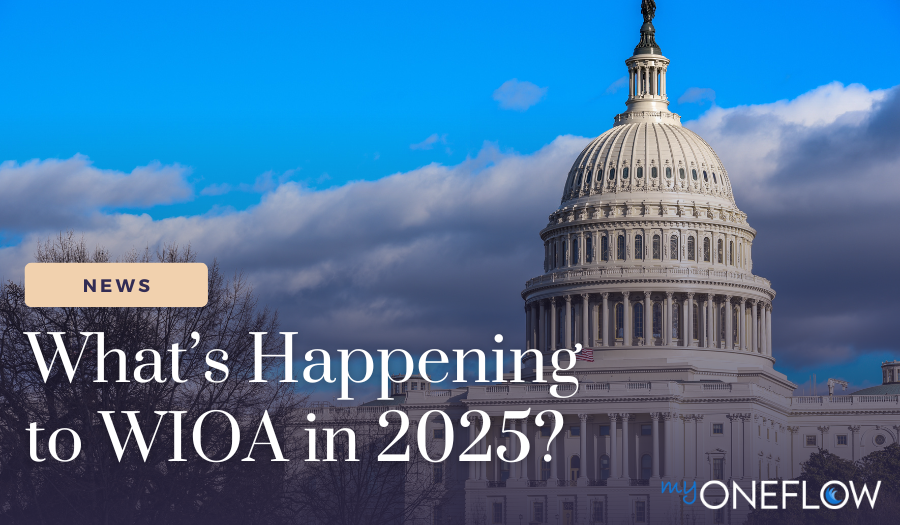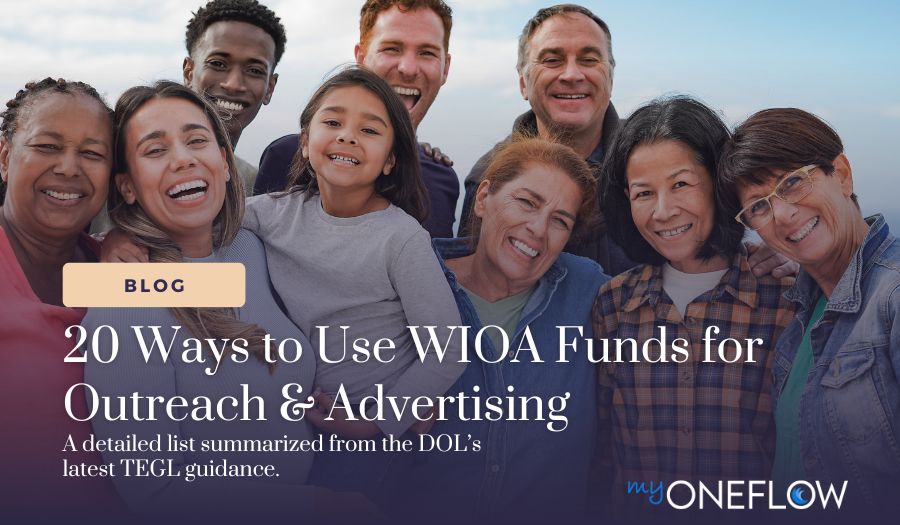The Future of WIOA: Many Providers, One Network
The Workforce Innovation and Opportunity Act (WIOA) was signed into law in 2014 to replace its predecessor, the Workforce Investment Act (WIA). The...

This post was last updated on January 2, 2025. To stay informed on future updates, please subscribe to the newsletter.
Ongoing Challenges with WIOA Reauthorization: Despite bipartisan support, differences between House and Senate proposals and tight legislative timelines have delayed reauthorization since WIOA expired in 2020. A bipartisan compromise bill is in play but faces hurdles for passage before the end of the legislative session.
Impact of New Congressional Leadership in 2025: Rep. Tim Walberg (R-MI) will replace Rep. Virginia Foxx (R-NC) as chair of the House Education and Workforce Committee. This leadership shift, coupled with competing legislative priorities, could further complicate reauthorization efforts if delayed into the new Congress.
The 50% Training Mandate: The compromise bill retains a controversial requirement that 50% of local funding be allocated to training, though up to 8% can now be used for supportive services. This provision remains a critical sticking point for local workforce boards concerned about reduced flexibility.
Implications for Service Providers: Service providers must prepare for stricter performance-based reporting requirements, particularly around job placement and earnings outcomes. Technology upgrades for compliance and data tracking will be essential to meet new standards under the reauthorization.
The Workforce Innovation and Opportunity Act (WIOA) expired in 2020, leaving workforce development agencies in a state of limbo. Federal funding for workforce programs has declined by 45% over the past two decades, and in the absence of updates, workforce systems are struggling to meet the economic and employment challenges of today. Reauthorization of WIOA remains critical to bolstering the workforce and equipping communities to address ongoing labor market needs.
Over the years, WIOA reauthorization has seen both momentum and setbacks. In May 2022, the House passed WIOA of 2022 (H.R.7309), which would have reauthorized and fully funded WIOA programs with nearly $80 billion over the next six years. Unfortunately, it did not achieve the bipartisan support it needed to move forward in the Senate. In 2023, the House passed A Stronger Workforce for America Act (H.R. 6655), which proposed several updates to WIOA, including a controversial mandate that 50% of funds be allocated specifically for training. This provision raised concerns among local workforce boards over potential reductions in funding for other critical services, like childcare and transportation assistance. The Senate, meanwhile, proposed a discussion draft that excluded the training mandate, among other key changes. Despite bipartisan support for reauthorization, significant differences between the House and Senate proposals have slowed progress, leaving the final outcome uncertain.
As we enter 2025 with a new administration and changes in congressional leadership, the trajectory of reauthorization is coming into sharper focus. However, key questions remain about its timing and impact on the workforce system. If WIOA remains unauthorized at the start of the new administration, it could be susceptible to additional budget cuts in light of the proposed Department of Government Efficiency's goals for reduced government spending.
Momentum for WIOA reauthorization picked up in the latter half of 2024. By November, staffers from both the House and Senate education committees announced a compromise bill following months of negotiations. This bipartisan bill represented a significant achievement in what has otherwise been a contentious and divided Congress. Key provisions include the continuation of the 50% training requirement but with some added flexibility, allowing up to 10% of training funds to be used for supportive services. The compromise bill also ensures the repurposing of funds from H-1B visa fees into $5,000 Individual Training Accounts for displaced workers.
Other notable aspects of the reauthorization bill include:
The reauthorization proposes a 3% funding increase for Title I formula programs in FY 2025, with funding levels maintained through FY 2030.
The bill eliminates the requirement for local stakeholders and mandated one-stop partners to negotiate physical infrastructure cost-sharing. Instead, states will utilize the existing “state funding mechanism,” with a slight increase in WIOA contributions to cover these costs.
Out-of-school youth will now be referred to as “Opportunity Youth,” with added eligibility for new youth populations. The allocation for Title I Youth funding is modified to allow 70% for Opportunity Youth activities and 30% for in-school youth.
A new $65 million competitive grant program, the Youth Apprenticeship Readiness Grant, is introduced to develop, expand, and improve youth apprenticeship programs. Efforts are aligned with Perkins V-funded programs.
Current WIOA governance structures remain intact, but representation of organized labor on local workforce boards is slightly increased.
The Strengthening Community Colleges Workforce Development Grants Program is codified to boost workforce development efforts at community colleges.
However, not all advocates were satisfied. Community colleges' push for automatic inclusion on the Eligible Training Provider List fell short, as did efforts to simplify ETPL processes for training programs. Instead, the bill introduces stricter performance-based measures for ETPL inclusion, emphasizing job placement and earnings outcomes over other criteria.
Many policymakers hoped to attach the reauthorization to the Continuing Resolution (CR) passed in late December to fund the government into early 2025; unfortunately, it was ultimately not included in the CR. Once again, reauthorization remains unclear, and the path forward under a new Congress could be fraught with challenges.
The shift to a new administration and new leadership will inevitably shape WIOA’s trajectory in 2025. Rep. Tim Walberg (R-MI) is set to take over as chair of the House Education and Workforce Committee, succeeding Rep. Virginia Foxx. Walberg's priorities include expanding apprenticeships, promoting short-term Pell Grants, and bridging the gap between education and industry needs. However, Foxx’s departure raises questions about the future of her more rigid priorities, such as the 50% training mandate embedded in the current compromise bill.
Meanwhile, the urgency to reauthorize WIOA early in the new year remains high. Without reauthorization, the law remains vulnerable in budget negotiations as an “unauthorized” program, with the potential for funding cuts—especially under a Republican-led Congress looking to tighten government spending.
Should Congress fail to enact the reauthorization soon, local workforce boards may face prolonged uncertainty. New committee chairs, legislative priorities, and competing demands could delay progress and leave workforce systems operating under outdated structures and without critical updates to funding mechanisms.
For WIOA service providers, the stakes in 2025 could not be higher. While bipartisan support for workforce development is strong, the details of reauthorization will determine whether local workforce boards can sustain or scale their services. The compromise bill’s 50% training mandate, even with the 8% allowance for supportive services, raises operational concerns for local boards that lean on flexible WIOA funding to meet diverse community needs. If passed, boards may need to redirect resources, potentially leading to staffing reductions or fewer supportive services.
Technological infrastructure will also play a central role. The renewed focus on performance measurement and data-based accountability, particularly for inclusion on the ETPL, will require providers to collect and report more robust data. This means workforce agencies must prioritize investment in systems that can track outcomes efficiently and demonstrate compliance with new requirements.
On the positive side, the bill's inclusion of SCCTG funding signals an increased national commitment to community colleges and sector partnerships. These investments are critical for scaling workforce development initiatives and aligning training opportunities with evolving labor market needs.
For service providers, preparation is key. Tools like myOneFlow can help agencies adapt to evolving WIOA reporting standards and compliance requirements. With WIOA’s future still uncertain, having a flexible and responsive system in place will be essential for managing change and sustaining community impact.
WIOA reauthorization has been a long time coming, and as we cross into 2025, its passage remains a top priority for workforce advocates. But even after clearing this hurdle, the real work will begin. Local boards, service providers, and policymakers must work together to implement whatever changes the new law brings, ensuring that it addresses the needs of job seekers and employers alike.
The coming months will determine not only the future of WIOA but also the ability of workforce systems to adapt to a rapidly changing economy. Service providers should stay engaged, advocate for their communities, and prepare for the impact of transformation. Whether reauthorization happens this year or next, one thing is clear: the workforce development field is on the brink of change. Will it be for better or worse? That answer remains to be seen.
myOneFlow is the only WIOA management platform that enables providers to manage and report on clientele from application through job placement and beyond. Our developers constantly update myOneFlow to reflect the evolving needs of WIOA service providers, so regardless of changes in legislation, your office stays compliant and can scale its impact. Contact our team of experts today to discuss how myOneFlow can help your organization prepare for upcoming changes to WIOA.
WIOA reauthorization remains uncertain heading into 2025. While a bipartisan compromise bill was introduced in late 2024, time constraints and legislative hurdles have delayed its passage. If not passed before Congress transitions, the new leadership in 2025 will need to revisit the reauthorization process, potentially complicating timelines and priorities.
The 50% training mandate requires local workforce boards to dedicate half of their funding to training programs while allowing up to 8% to be used for supportive services like transportation and childcare. While this aims to enhance skills development, many boards are concerned it could limit their flexibility to fund other critical services and workforce programs tailored to community needs.
The new congressional leadership in 2025, including Rep. Tim Walberg as Chair of the House Education and Workforce Committee, could shift priorities for WIOA reauthorization. Walberg’s focus on expanding apprenticeships and short-term Pell Grants may influence the direction of workforce development policies, but the absence of Rep. Virginia Foxx, a driving force behind the reauthorization, adds uncertainty to the process.
The compromise bill retains the 50% training mandate with added flexibility, repurposes H-1B visa fees toward individual training accounts, and emphasizes performance-based metrics for program eligibility on the Eligible Training Provider List (ETPL). It also officially authorizes the Strengthening Community Colleges Workforce Development Grant program, reflecting an increased focus on community colleges and sector partnerships.
Service providers should invest in technology to comply with stricter performance-based reporting requirements around job placement and earnings outcomes. They should also prepare for possible shifts in funding and explore partnerships that align with the increasing focus on skills and training. Proactive advocacy with policymakers and staying informed about legislative developments will be crucial as reauthorization moves forward.

The Workforce Innovation and Opportunity Act (WIOA) was signed into law in 2014 to replace its predecessor, the Workforce Investment Act (WIA). The...

The Workforce Innovation and Opportunity Act (WIOA) is rooted in a bold ambition: “to strengthen the United States workforce development system...

The U.S. Department of Labor recently released a new Training and Employment Guidance Letter (TEGL), TEGL 03:23, to provide workforce agencies and...